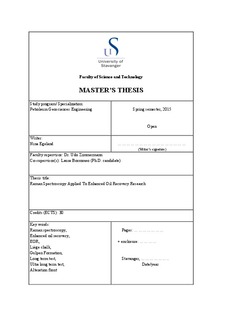| dc.contributor.author | Egeland, Nina | |
| dc.date.accessioned | 2015-10-12T13:24:44Z | |
| dc.date.available | 2015-10-12T13:24:44Z | |
| dc.date.issued | 2015-06-09 | |
| dc.identifier.uri | http://hdl.handle.net/11250/2354110 | |
| dc.description | Master's thesis in Petroleum geosciences engineering | nb_NO |
| dc.description.abstract | It is well established that aqueous chemistry affects the mechanical strength of chalk. Seawater tends to weaken chalk at reservoir temperatures and consequently the recovery rate. As more than 50 % of the oil in existing fields on the Norwegian Continental Shelf cannot be produced with current methods, many research projects concerning enhanced oil recovery (EOR) have been initiated, which is also the background for this study.
Raman spectroscopy is a non-destructive, quick, analytical method getting more and more attention in the oil industry. The objectives of this study were to describe the methodology of Raman spectroscopy, and to apply this methodology to two core samples of chalk flooded with MgCl2 in order to describe and quantify the effects of flooding processes. When chalk is injected with MgCl2, ion exchange will take place and may result in growth of new mineral phases. Magnesite (MgCO3) was identified as the major newly grown mineral phase in these samples. The extent of the injection period was different for the two samples from chalk exposures close to Liège (Belgium) of Upper Cretaceous age; LTT was flooded for 1.5 years and ULTT for 3 years.
Raman spectroscopy quickly confirmed that in the ULTT sample sufficient amount of Mg2+ was exposed to ion exchange to form magnesite throughout the whole injection period, resulting in a magnesite content of 81 %. Raman spectroscopy could identify a decreasing occurrence of magnesite along the core of LTT. The magnesite abundance decreases from
51 % to 15 % within the first 4 cm of the core (slice 1-4). In previous research, magnesite was traced up to slice 3, while in this study magnesite was detected in slice 4, suggesting the alteration front to be located within this slice.
These results strengthen the possibility of the application of Raman spectroscopy as a quick, cheap, and effective methodology for the study of mineral compositions and even fine- grained rock material like chalk. | nb_NO |
| dc.language.iso | eng | nb_NO |
| dc.publisher | University of Stavanger, Norway | nb_NO |
| dc.rights | Navngivelse 3.0 Norge | * |
| dc.rights.uri | http://creativecommons.org/licenses/by/3.0/no/ | * |
| dc.subject | petroleumsteknologi | nb_NO |
| dc.subject | petroleum engineering | nb_NO |
| dc.subject | Raman spectroscopy | nb_NO |
| dc.subject | EOR | nb_NO |
| dc.subject | Gulpen Formation | nb_NO |
| dc.subject | Liège Chalk | nb_NO |
| dc.subject | petroleumsgeologi | nb_NO |
| dc.subject | enhanced oil recovery | nb_NO |
| dc.subject | long term test | nb_NO |
| dc.subject | ultra long term test | nb_NO |
| dc.subject | alteration front | nb_NO |
| dc.title | Raman spectroscopy applied to enhanced oil recovery research | nb_NO |
| dc.type | Master thesis | nb_NO |
| dc.subject.nsi | VDP::Technology: 500::Rock and petroleum disciplines: 510::Geological engineering: 513 | nb_NO |
| dc.subject.nsi | VDP::Mathematics and natural science: 400::Geosciences: 450::Petroleum geology and petroleum geophysics: 464 | nb_NO |

